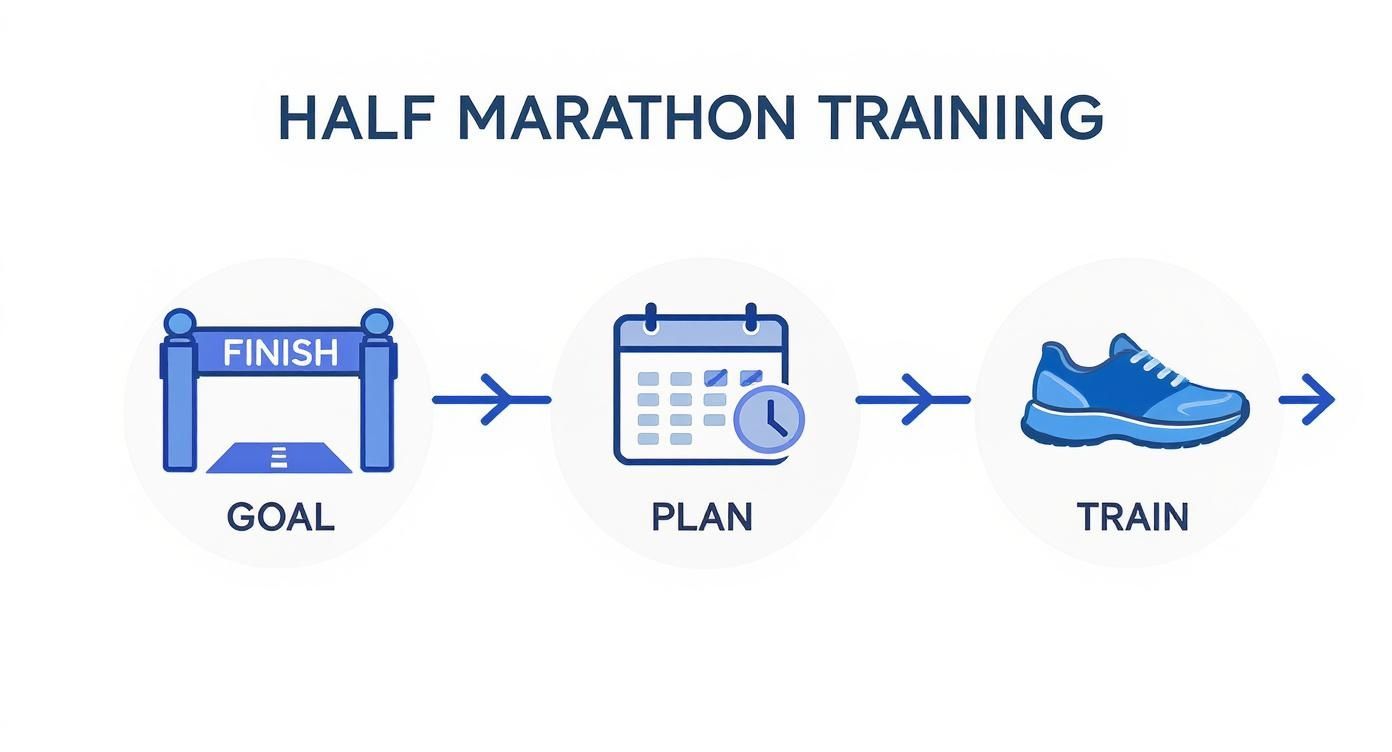Training for a half marathon isn't just about logging miles—it's about training smart. The entire process hinges on three simple but powerful ideas: showing up consistently, gradually running farther, and giving your body the rest it needs to adapt.
Most effective training plans span about 10-12 weeks. This timeframe gives you a solid runway to build endurance through a carefully planned mix of long runs, easy recovery jogs, and cross-training. It's this combination that gets your body ready to confidently tackle the 13.1-mile distance.
Your Journey to the Half Marathon Finish Line
Crossing that finish line is a feeling you'll never forget, but the real victory starts months earlier. It begins the moment you decide to commit and take that first step. Whether you just want to finish with a smile on your face or you're chasing a personal best, understanding the fundamentals of training is what will get you there.
Let's break down exactly what you need to know, starting with setting a goal that makes sense for you.
Setting Realistic Expectations
Before you even think about your first long run, it helps to have a rough idea of what you're aiming for. For most first-timers, the goal is simply to complete the race, and that's a fantastic achievement in itself. Still, having a time in mind can be a huge motivator.
So, what's a "typical" time? Based on data from over 124,000 race results, the average half marathon finish time is 1 hour, 50 minutes, and 15 seconds. Men tend to finish around 1 hour and 43 minutes, while women average just over 2 hours. These aren't rules, just benchmarks to help you set a target that feels both challenging and achievable.
The Building Blocks of Training
A good training plan isn't a non-stop grind of running as far as you can. It's a balanced recipe designed to build your strength and stamina while keeping injuries at bay. Think of it as a system where every single workout has a specific job to do.
The best training plan is the one you can stick to consistently. Don't worry about perfection; focus on showing up for your runs, listening to your body, and celebrating the small wins along the way. Your commitment is what will carry you across the finish line.
Every solid training schedule is built around a few non-negotiable types of workouts. These are the backbone of your preparation, and each one plays a unique role in getting you race-ready.
Here’s a quick look at the core components you'll find in almost any half marathon plan. Understanding what each workout does will help you appreciate why you’re doing it, especially on days when motivation is low.
Core Components of a Half Marathon Training Plan
| Workout Type | Frequency (per week) | Purpose |
|---|---|---|
| Long Run | 1 | The most critical workout. Builds the endurance and mental grit needed to cover the full distance. |
| Easy/Recovery Run | 2-3 | Short, low-intensity runs that help your body recover while adding to your weekly mileage base. |
| Cross-Training | 1-2 | Activities like cycling or swimming that build fitness without the impact of running. Great for injury prevention. |
| Rest Day | 1-2 | Absolutely essential. This is when your muscles repair and get stronger. Skipping rest is a fast track to burnout. |
These elements work together to create a balanced approach. The long runs build your endurance, the easy runs help you recover, cross-training builds all-around fitness, and rest days are when the magic of adaptation really happens.
Finding the Right Half Marathon Training Plan
Picking a half-marathon training plan is a lot like finding the perfect pair of running shoes—what works for your friend might be a disaster for you. Your current fitness, running history, and what you hope to achieve on race day are the biggest factors. A plan that’s too easy will leave you underprepared, but one that’s too aggressive is a fast track to injury or burnout.
The first step is always an honest look in the mirror. Are you lacing up for your first 13.1-mile adventure with the simple goal of finishing? Or are you a seasoned runner chasing a new personal record? Each path requires a totally different roadmap.
Let's break down three different 12-week training plans designed for beginner, intermediate, and advanced runners. Each one is built to get you to the starting line feeling prepared, confident, and ready to run your race.
The Beginner Half Marathon Plan
For anyone tackling their first half marathon, the goal is straightforward but incredibly rewarding: finish the race feeling strong and healthy. This plan is all about building a solid endurance base through consistency. Your weekly long run is the star of the show here, as you gradually add distance week after week.
If you're truly starting from square one, jumping right into a half marathon plan can feel intimidating. Our guide on creating a running schedule for beginners is a great place to build your initial fitness. This plan assumes you can already run or run/walk for about 3 miles at a time.
A typical week usually involves:
- Two short, easy runs (2-3 miles) to maintain your base.
- One cross-training day (think swimming, cycling, or the elliptical) to boost cardio without the pounding.
- One long, slow run on the weekend, starting around 3 miles and adding about a mile each week.
- Two or three essential rest days for muscle repair and adaptation.
You won't find any complicated speed work, like intervals or tempo runs, in the beginner plan. The entire focus is on getting your body used to spending more time on your feet and building the mental grit to cover the distance.
The Intermediate Runner Plan
Already have a few 5Ks or 10Ks under your belt? If you’re consistently running 15-20 miles per week, the intermediate plan is your sweet spot. Here, the goal shifts from just finishing to actually improving your performance. We'll start introducing workouts specifically designed to make you faster.
This plan weaves in more structured speed work. You’ll still have your weekly long run and a couple of easy days, but we'll swap one of those runs for a quality workout.
Key workouts for the intermediate runner:
- Tempo Runs: This is your "comfortably hard" pace—a speed you could hold for about an hour. A classic tempo workout is a 1-mile warm-up, 3-4 miles at tempo pace, and a 1-mile cool-down.
- Strides: After an easy run, you'll do four to six 100-meter accelerations. These aren't all-out sprints; they’re smooth and controlled, designed to improve your form and running economy.
Your weekly mileage will naturally climb, peaking around 25-30 miles. This extra volume, combined with targeted speed work, helps raise your lactate threshold, which is a fancy way of saying you'll be able to run faster for longer before fatigue sets in.
The Advanced Runner Plan
For the runner who lives and breathes mileage and is looking to smash a personal best, the advanced plan is where the magic happens. This is for athletes who are already running 30+ miles per week and are familiar with different kinds of speed work. We’re not just building fitness anymore; we're fine-tuning the engine.
Be warned, these plans are demanding. They require a serious commitment to both the hard workouts and the crucial recovery that follows.
You can expect to see workouts like:
- Interval Training: Think short, intense bursts of running followed by recovery jogs. A classic example is 6×800 meters at your 5K race pace, with a 400-meter recovery jog between each repeat.
- Hill Repeats: There's no better way to build pure leg strength and power. A session might involve running hard up a moderate hill for 60 seconds, jogging back down, and repeating 8-10 times.
Even your long runs get a makeover in an advanced plan. Instead of just logging easy miles, you might run chunks of it at your goal half marathon pace to get your body and mind ready for race day.
The infographic below offers a great visual of the entire process, from setting your goal to crossing that glorious finish line.

It’s a simple reminder that a solid plan is the bridge connecting your ambition to your execution. Each icon represents a critical piece of the puzzle.
How to Choose Your Plan
So, which plan is for you? It really comes down to being honest with yourself. Don't let your ego write a check your body can't cash.
This table breaks down the core differences to help you decide.
Beginner vs Intermediate vs Advanced Training Focus
| Training Element | Beginner Focus | Intermediate Focus | Advanced Focus |
|---|---|---|---|
| Primary Goal | Finish the race comfortably | Improve time and performance | Achieve a new personal record |
| Weekly Mileage | 10-20 miles | 20-30 miles | 30-40+ miles |
| Long Run | Gradually increase distance | Increase distance, may add some pace work | Race-pace simulations and long distances |
| Speed Work | None | Tempo runs, strides | Interval training, hill repeats, tempo runs |
| Cross-Training | Essential for building fitness safely | Important for injury prevention | Strategic for recovery and strength |
| Rest Days | 2-3 per week | 2 per week | 1-2 per week, with active recovery |
At the end of the day, remember that any good training plan has to be flexible. Life happens. If you miss a run, don’t sweat it. Consistency over the long haul is what truly matters. Just listen to your body, stay the course, and enjoy the journey.
Smart Mileage and Pacing Strategies
Getting ready for a half marathon is about more than just logging miles—it's about logging smart miles. This is where we get strategic, building a solid foundation that gets you stronger week after week without burning you out. The goal is to balance the stress of training with the recovery your body absolutely needs to adapt and improve.

If there's one secret to success, it's consistency. Showing up and putting in the work, week after week, is what builds the aerobic engine you need to cover 13.1 miles. This isn't just anecdotal wisdom, either. Research backs it up, showing that a higher weekly training volume—specifically running more than 32 kilometers (about 20 miles) per week—is a key factor in faster half marathon times. You can dig into the full study on mileage and race performance to see just how strong the connection is.
Safely Increasing Your Weekly Mileage
The classic rookie mistake? Trying to do way too much, way too soon. Your body is incredible, but your muscles, tendons, and ligaments all need time to catch up to your ambition.
To sidestep the frustrating cycle of overtraining and injury, experienced runners live by a simple but powerful guideline: the 10% rule.
It's exactly what it sounds like: never increase your total weekly mileage by more than 10% from the week before. So, if you ran 15 miles this week, you'll cap next week at 16.5 miles. This slow-and-steady progression allows your body to adapt without being pushed past its breaking point.
Following the 10% rule isn't a sign of weakness; it's a sign of intelligence. The smartest runners aren't always the fastest—they're the ones who make it to the starting line healthy.
Most solid training plans also build in a "cutback" or "recovery" week every three or four weeks. On these weeks, you’ll intentionally drop your total mileage by 20-30%. This planned break is crucial for deep recovery and helps lock in your fitness gains before you start building again.
Understanding Your Training Paces
Not all runs should feel the same. If you head out the door and run at the exact same pace every single day, you're leaving a ton of potential on the table. To become a more efficient and resilient runner, you need to work with a variety of paces, each with its own job to do.
Think of it like a toolkit. You'll want to get comfortable with three key paces:
Easy Pace: This is your bread and butter, making up 70-80% of your total running. It’s a comfortable, conversational pace where you could easily hold a chat without gasping for air. These runs are aerobic powerhouses, building your endurance and teaching your body to become a fat-burning machine.
Tempo Pace: Often described as "comfortably hard," this is a pace you feel like you could hold for about an hour if you had to. Tempo runs are fantastic for raising your lactate threshold, which basically means you can run faster for longer before that familiar leg fatigue sets in. A typical session might include a warm-up, 20-30 minutes at tempo pace, and a cool-down.
Race Pace: This is your goal pace for the 13.1 miles. Weaving this pace into some of your long runs is key. It gets your body and mind dialed into the specific effort you'll need on the big day, building massive confidence and making the pace feel almost automatic when it really counts.
Putting It All Together
So, what does this look like in a real-world training week? A well-structured plan will mix these different efforts to get you fitter while keeping injury risk low.
Here’s a sample week for an intermediate runner:
| Day | Workout Type | Purpose |
|---|---|---|
| Monday | Rest or Cross-Train | Active recovery, building non-impact strength. |
| Tuesday | Easy Run (3 miles) | Building the aerobic base and aiding recovery. |
| Wednesday | Tempo Run (5 miles total) | Improving lactate threshold and speed endurance. |
| Thursday | Easy Run (3 miles) | Maintaining mileage, promoting blood flow. |
| Friday | Rest | Full recovery before the weekend's long run. |
| Saturday | Long Run (8 miles) | Building endurance, practicing race pace. |
| Sunday | Active Recovery | A light walk or some stretching. |
This kind of structure ensures every run has a purpose. You’re not just logging mindless miles; you’re strategically building yourself into a runner who will cross that finish line feeling strong, prepared, and ready to celebrate.
Strength Training and Injury Prevention for Runners

While racking up the miles is obviously central to any half marathon plan, what you do off the pavement is just as crucial. A strong, resilient body is your best defense against the repetitive stress running puts on your joints and muscles.
Think of strength training less as an optional add-on and more as essential maintenance. It's how you build a more efficient, durable, and injury-proof running machine. Skipping this work is one of the fastest tickets to common ailments like shin splints, IT band syndrome, or runner's knee.
Just two short sessions a week dedicated to targeted exercises can dramatically improve your running economy—meaning you use less energy at any given pace—and fortify your body against the grind of training.
Building a Runner-Specific Strength Routine
You don't need a complicated gym routine or heavy weights to build the kind of strength that matters for running. The real goal is to focus on movements that support and mimic the running motion. That means zeroing in on the key powerhouses: your glutes, core, and legs.
A simple, effective routine can be done right at home with minimal equipment. I always tell runners to aim for two 20-30 minute sessions each week. Squeeze them in on your cross-training days or after an easy run for the best results.
Here are three foundational exercises every runner should have in their arsenal:
- Squats: This is the ultimate leg and glute strengthener. Focus on keeping your chest up and sinking your hips back as if you're sitting in a chair. Good form is always more important than how many you can do.
- Lunges: As single-leg movements, lunges are fantastic for improving balance and ironing out strength imbalances between your legs. Mix it up with forward, reverse, and lateral lunges to hit different muscles.
- Planks: A strong core is the bedrock of good running form. Planks light up your entire midsection, helping you stay stable and upright, especially when you start to get tired on those long runs.
Your strength routine is your body's insurance policy. It's the proactive work that ensures you can handle the cumulative impact of thousands of steps, keeping you healthy and consistent all the way to the finish line.
Beyond these staples, I’d highly recommend adding in glute bridges to really fire up your primary running muscles and push-ups to build upper body strength, which helps with your arm drive and posture.
Smart Tactics for Injury Prevention
Staying healthy during a training block is a skill you can develop. It’s about being proactive, listening to your body, and prioritizing smart recovery habits, not just pushing through.
The Warm-Up and Cool-Down
Never, ever jump into a run cold. A solid 5-10 minute warm-up with dynamic movements—think leg swings, walking lunges, and high knees—gets your muscles ready for the work ahead. Just as important is the cool-down. Finish every run with 5-10 minutes of walking followed by some static stretching to improve flexibility and jump-start the recovery process.
The Power of Foam Rolling
A foam roller is like having your own personal massage therapist on call. Regularly rolling out tight spots in your quads, hamstrings, and calves helps release muscle knots, improve blood flow, and stop nagging tightness from turning into a full-blown injury.
Listen to Your Body
This is hands down the most critical skill for injury prevention. You have to learn the difference between normal training fatigue—that good, satisfying ache after a tough workout—and the sharp, persistent, or localized pain that’s waving a red flag. Pushing through real pain is never a winning strategy. It only leads to setbacks.
Remember, everything in your body is connected. Your feet, for example, play a massive role. For runners dealing with specific biomechanical issues, finding the best running shoes for flat feet can be a total game-changer, preventing alignment-related injuries all the way up the chain in your knees and hips. It’s all about building a solid foundation from the ground up.
Fueling Your Body for Peak Performance

Putting in the miles is only half the battle. The other, equally critical, piece of the puzzle is how you fuel your body to handle all that work. Don't think of nutrition and hydration as a "diet"—it's a core part of your training, just as essential as your weekly long run.
Get your fueling right, and you'll have the energy to power through tough workouts, recover faster, and avoid hitting that dreaded "wall" on race day. What you eat before, during, and after your runs truly makes all the difference in your performance and how you feel.
Your Everyday Running Diet
Long before we talk about race-day strategy, your daily eating habits are laying the groundwork for success. A balanced diet built on whole foods provides the steady, reliable energy your body craves.
The key is getting a solid mix of macronutrients. For any endurance athlete, carbs are king—they're your primary fuel source. Try to get about 50-65% of your daily calories from complex carbohydrates like whole grains, fruits, and vegetables.
Of course, you still need protein for muscle repair and healthy fats for overall function. The best advice? Don't overthink it. Just focus on eating real, unprocessed foods most of the time.
What to Eat Before Your Runs
Eating before a run is all about topping off your glycogen stores—your body's quick-access energy tank. The golden rule here is to stick with something high in carbohydrates but low in fat and fiber. This gives you the energy you need without risking digestive drama mid-run.
The timing and size of your meal really depend on how long you'll be out there:
- For long runs (over 60-90 minutes): You'll want a more substantial meal 2-3 hours beforehand. A classic bagel with peanut butter or a bowl of oatmeal with a banana are go-to options for a reason.
- For shorter runs: A small, easy-to-digest snack 30-60 minutes before you head out is perfect. Think half a banana, a few crackers, or a handful of pretzels.
The most important thing is to experiment during your training runs to see what sits well in your stomach. The last place you want to try something new is on the starting line.
Fueling During Long Runs
Once your runs start stretching beyond the 75-90 minute mark, your body's stored energy begins to dwindle. This is where on-the-run fueling becomes non-negotiable if you want to maintain your energy and pace.
A good rule of thumb is to take in 30-60 grams of carbohydrates per hour after that first hour of running. This is the role that energy gels, chews, and sports drinks were designed to fill.
You have to practice your mid-run fueling strategy on every single long run. Your gut needs to be trained just like your legs. This is your chance to figure out which gels or chews agree with your system and exactly how often you need to refuel to feel strong to the finish.
I always suggest taking your first gel or chews around the 45-60 minute mark, then continuing every 45 minutes or so from there. And always, always take them with water—it's crucial for helping your body absorb the fuel efficiently.
Post-Run Recovery Nutrition
Believe it or not, what you eat after a run is just as vital as what you ate before. Your two main goals are simple: replenish the glycogen you just burned and provide protein to start repairing your muscles.
The ideal time to do this is within 30-60 minutes of finishing your run. This is often called the "recovery window" because your body is primed for nutrient absorption. Aim for a snack or meal with a 3:1 or 4:1 ratio of carbohydrates to protein.
Some of my favorite recovery options are:
- Chocolate milk (it's naturally the perfect ratio!)
- A smoothie made with fruit and protein powder
- Greek yogurt topped with berries
- A simple turkey sandwich on whole-wheat bread
Nailing your recovery nutrition will drastically reduce muscle soreness and get you back on your feet and ready for the next run.
Your Race Day Game Plan
All that hard work is about to pay off. You’ve logged the early morning runs, conquered the long weekend miles, and put in the time with your strength work. This is it. The final stretch isn't about getting fitter—that job is done. Now, it’s all about showing up to the starting line rested, prepared, and brimming with confidence.
Believe it or not, your race day success is locked in long before the starting gun fires. It starts with your taper, flows through a well-practiced morning routine, and is cemented by a smart pacing strategy. Let's walk through these final pieces so you can have an amazing race.
Embrace the Taper
It sounds completely backward, but in the final week or two before your race, the most important thing you can do is run less. This is the taper, and it's where the real magic happens. This is your body’s chance to fully recover and absorb all the tough training you've put in. Cutting back your mileage lets your muscles repair completely and tops off your energy stores.
During your taper week, you’ll want to slash your total running volume by 40-60%. The runs you do should be short and feel easy. You might throw in a few short bursts at your goal race pace, just to keep your legs feeling snappy, but that's it.
Whatever you do, resist the temptation to squeeze in one last long run. Trust your training. The hay is in the barn, as they say. Arriving at the start line feeling fresh is infinitely more valuable than a few extra, last-minute miles.
Your Race Morning Checklist
A chaotic race morning can sabotage your performance before you even start running. The secret to a smooth morning? Practice. Treat your last big long run as a full dress rehearsal for the main event.
This means having a plan for everything, from what you'll eat to when you'll arrive.
Breakfast of Champions: Now is not the time to experiment. Eat the exact same pre-run meal you’ve been eating before your long runs. You're looking for something high in carbohydrates that’s easy on your stomach, ideally 2-3 hours before the gun goes off. There's a reason a bagel with peanut butter or a simple bowl of oatmeal are runner favorites.
Dress for Success: Become a weather-checking fanatic in the days leading up to the race. Plan your outfit, but have a backup plan, too. A great rule of thumb is to dress as if it's 10-15 degrees warmer than the actual temperature—you’ll warm up fast once you get moving.
Logistical Planning: Figure out exactly how you're getting to the race, where you'll park, and the location of essentials like bag check and the porta-potties. Give yourself way more time than you think you need. Arriving calm and collected is a huge competitive advantage.
"The main thing here is to stick with what keeps you fueled, with what works for YOU and what makes you feel YOUR best. Race how you train."
This philosophy is your golden rule for race day. It applies to your food, your gear, and most importantly, your pacing. Don't try anything new.
Pacing for a Strong Finish
I’ve seen it a thousand times: the single biggest mistake runners make in a half marathon is starting out way too fast. The adrenaline is pumping, the crowd is electric, and it's incredibly easy to get swept up in the excitement, only to burn through all your energy in the first few miles.
A smart pacing strategy is your secret weapon. It’s how you finish feeling strong, not just hanging on.
Breaking Down the 13.1 Miles
Instead of staring down the barrel of one long 13.1-mile race, break it into three smaller, more manageable chunks. This little mental trick makes the distance feel far less daunting and helps you stay in control.
Miles 1-3: The Warm-Up: These first few miles should feel almost too easy. The goal here is to run them a touch slower than your target race pace. Use this time to settle your nerves, find a comfortable rhythm, and conserve that precious energy. Don't waste effort weaving frantically through the crowds; just relax and focus on your breathing.
Miles 4-10: Cruise Control: This is the heart of the race. It's time to settle into your goal half marathon pace and lock it in. This section should feel "comfortably hard"—you're working, but you're in control and it feels sustainable. Focus on maintaining a consistent effort, especially if you hit any hills.
Miles 11-13.1: The Finish: Here we go. This is where you get to spend all that energy you so wisely saved. With just a 5K to go, you can start to gradually pick up the effort. Focus on catching the runner ahead of you, then the next one. Let the energy of the cheering crowds carry you home to that well-deserved finish line.
Got Questions About Half Marathon Training?
Even with the perfect training plan in hand, you're bound to have questions. Let's be real, taking on a 13.1-mile race is a huge deal, and it's totally normal to wonder if you're doing things right.
Think of this as your quick-reference guide. I’ve pulled together answers to the most common questions that pop up for runners training for their first—or tenth—half marathon. The goal here is to clear up any confusion so you can focus on your training with confidence.
How Long Does It Really Take to Train?
For most runners starting out, a solid 10-12 week training plan is the sweet spot. That’s about three months, which gives your body enough time to safely build up the mileage and endurance. Rushing this process is one of the fastest ways to get injured, so giving yourself this runway is crucial.
Now, if you’re already running consistently and have a good base, you might be able to get race-ready in 6-8 weeks. The main thing is that you should already be comfortable running a few miles without stopping before you jump into a shorter plan.
Is It Okay to Walk During a Half Marathon?
Yes! A thousand times, yes. It's time to bust the myth that walking during a race means you've failed. Honestly, that couldn't be further from the truth. A run-walk strategy is one of the smartest ways to approach the distance.
By taking planned, short walk breaks, you can conserve a ton of energy, keep fatigue from setting in too early, and make the whole 13.1 miles feel way less intimidating. I've seen everyone from brand-new runners to seasoned vets use this method to finish feeling strong.
The goal is to cross that finish line, simple as that. A run-walk approach is a powerful tool to get you there. It’s a sign of smart racing, not a lack of fitness.
What’s the Toughest Part of Training?
Every runner's experience is different, but a couple of challenges seem to pop up for almost everyone. The first is the long run. As that weekly long run gets longer and longer, it really starts to test you, both physically and mentally. It’s a battle of endurance and pure grit.
The other major hurdle? Just staying consistent. Life has a funny way of getting in the way, and sticking to your training schedule week in and week out takes some serious dedication. Pushing through those "I don't feel like it" moments is just as big of a win as nailing a new long-run distance.
At THE RUNNING, we're all about giving every runner access to expert advice that works. Our site is packed with training plans, gear reviews, and tips to keep you healthy and on track. Find everything you need to become a stronger, smarter runner at The Running.









